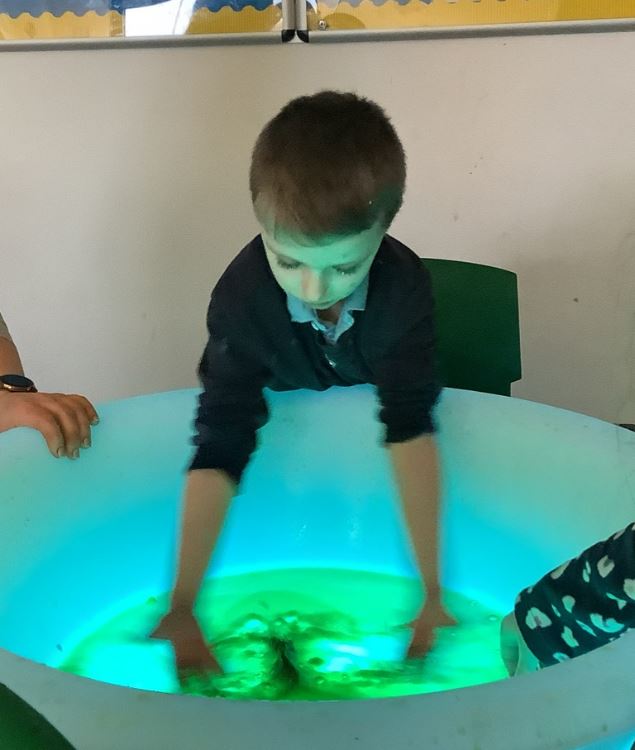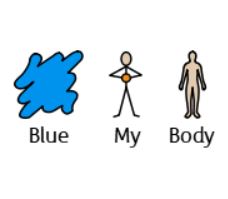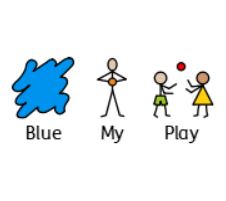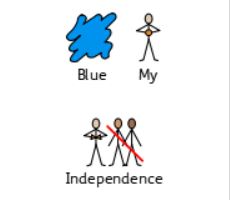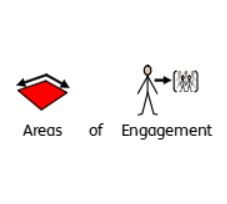Blue Pathway
Our Blue pathway is student centred and allows the complex needs of our students to be fully met. Our students usually have profound and multiple learning needs in addition to physical difficulties, complex medical conditions and/or sensory impairment. Our students operate within the early Pre Key Stage Levels and often remain within this range throughout their time with us.
Each student has individualised lesson outcomes for every lesson, based on their long term EHCP outcomes along with a developmental framework. This framework aids to help inform the planning of next steps in learning. There is a high staff to student ratio, resulting in students’ learning being constantly and consistently tracked while also providing a high level of personal care. Both teachers and teaching assistants have an in-depth knowledge of students’ needs and intended learning outcomes and know how to encourage and support these students in the best ways.

Implementation
Blue Pathway learners are working at an engagement level in most areas of their curriculum. They are not accessing subject-specific learning. Students working within this Pathway commonly present with the following characteristics:
-
Emerging intentional communication
-
Emerging social awareness
-
Emerging contextual awareness
-
Possible learnt responses to familiar routines
-
Beginning to develop joint attention
Built into the Blue pathway are 5 core areas of learning which are implemented into our students’ days. These are: My Body, My Thinking, My Communication, My Independence and My Play.
My Body
Teaching encompasses body awareness, fine motor movement, gross motor movement, mobility and emotional wellbeing. All of these areas facilitate developmental movement and encompass early sensorimotor development.
My Thinking
Developing thinking connects experiences and links ideas. Teaching in this area involves problem solving, intentional play, developing IT skills, maths & science. Learning is all exploratory and exposes learners to different experiences to link ideas.
My Communication
For many of our learners this is a key area of development. This area of learning teaches and promotes development in response, interaction, communication, reading and writing.
My Independence
Through the promotion of our learning values we promote independence in our learners so that they are able to participate and function within their world around them. We develop independence in eating and drinking, dressing and undressing, personal care, shopping, travel and cooking. All of these are key skills required within life.
My Play
The development of play encourages creativity and the whole individual. Experiences in this area promote development of play skills, interaction, self expression and creativity through the arts.
Our lessons take a sensory format, where we try to inspire as many of the senses as possible. This may be by using particular music to help students have an experience, it may be to use scents and tastes to aid exploration or it may be to offer particular textures. We feel that for many of our learners a whole body awareness is a key priority, along with developing tools to aid communication such as making a choice or communicating a need.
We repeat lessons over at least one half-term to help our students anticipate what is happening and begin to initiate new ways to explore or play or move. By working collaboratively with our associated therapists, we ensure the physiotherapy needs of our students are met. Similarly, our liaison with other educational professionals and outside agencies help us to constantly review our working strategies and develop best practice.
We monitor the learning of our students lesson by lesson; this takes the form of observational notes and photographic evidence. Due to the nature of the complex learning needs these students have, linear level assessment does not always best show the steps of progress made. We therefore track student progress and assess against their EHCP outcomes as an ongoing process. We feel it is important to celebrate the steps of progress our students make and strive to communicate this regularly with our parents/carers. We highly value home school communication and welcome parents/carers contributing to the learning outcomes of our students via our Evidence for Learning platform.
We track the engagement of our students according to the Engagement Model. Engagement identifies and celebrates all pupils’ progress, including linear and lateral progress, the consolidation and maintenance of knowledge, skills and concepts and the prevention or slowing of a decline in pupils’ performance, whilst recognising that a minority of pupils may have a regressive condition. Tracking and measuring engagement can help us reflect on how well our students bespoke curriculum is helping them progress. The model has 5 areas: exploration, realisation, anticipation, persistence and initiation. We measure progress through each of the 5 areas by identifying how established the pupil is against each of the areas of engagement. This then informs the next planning cycle to plan activities which develop and reinforce different areas.
We aspire for learners in the blue pathway will leave Key Stage 4 with a qualification in ASDAN Personal Progress and at least 3 AQA Unit Award certificates in recognition of their learning. These AQA Unit Award certificates will be tailored to their needs and interests and focus on key skills in life and living.
Impact
We know through observation and assessment, from feedback from parents/carers that our Blue Pathway has the following impact:
- learners improve their engagement with the world around them. This may be observed as a new ability to anticipate an event, recognition of a familiar person or peers or in any number of other ways
- young people develop their receptive and expressive communication skills, again allowing them deeper engagement with others
- students develop physical and mental wellbeing and robustness through our ongoing therapies and interventions
- Pupils become more able to understand and accept support around them, preparing them for their life after Highfield
Take a look at the overview for the Blue pathway curriculum here:
Progression
Learning progression is shown through the Long term plans in conjunction with the Blue Pathway Framework and Engagement Model. As many of our Blue pathway learners are at an exploratory stage of learning the main focus is promoting and increasing levels of engagement. This progress is measured through the Areas of Engagement. A variety of experiences and breadth of knowledge is provided by stimulating themes and topics linked to the students interests. Take a look at our themes of learning and long term plans here for more information: Blue Pathway Long Term Plan
Progression in skills and knowledge is carefully mapped within each curriculum area. For students with the most profound needs the focus is on repetition and increasing engagement over time. For more able learners who have developing levels of engagement, each area of learning has a detailed framework which outlines next steps in learning and smaller steps of development.
Click on the pictures of each area of learning where you will see the skills and knowledge progression maps.
Preparing for Adulthood
Preparing for Adulthood and developing key life skills are a key part of the curriculum for all Highfield pupils. These skills are embedded within each of our pathways and taught at the most appropriate level for the learner. This is the basis for our work related learning strategy and as our strap line states it prepares learners for the next step in education, life or work - whatever is appropriate for them.
Careful and highly individualised curriculum planning across the school is related to students EHCP Outcomes. It aims to give all pupils the opportunity to experience and learn to prepare for real life situations including self care, growing independence and exposure and experience of different environments. Take a look at our strategy and how we incorporate this into our curriculum below:
Our yellow and the majority of our green pathway learners move on at age 16 to an appropriate additional needs college course. These courses are classed as full time courses but are spaced over 3 days per week. We do not currently have a 6th form provision at Highfield Littleport as we do not have large enough numbers to make a viable cohort. Only learners within our complex green and blue pathway's will be eligible to study at our sixth form provision when it is developed and viable.
Blue Pathway End Points and Transition from Highfield
Outcomes for learners in the blue pathway varies according to the individual progress they make in their time at Highfield through the curriculum frameworks and against their EHCP outcomes. All students are entitled to leave with qualifications or recognition drawn from their learning within the five areas of learning in the blue pathway. In the blue pathway we use ASDAN Personal Progress as recognition of achievement and qualifications.
We aspire for learners in the blue pathway will leave Key Stage 4 with a qualification in ASDAN Personal Progress and at least 3 AQA Unit Award certificates in recognition of their learning. These AQA Unit Award certificates will be tailored to their needs and interests and focus on key skills in life and living.
Learners in the blue pathway are likely to stay on Highfield roll until the end of the year they are 19, unless there is an alternative placement that would suit the individual's needs better than continuation at HIghfield. Accessing LINC 19-25 is an option that can be explored if the individual's needs could be best met there subject to Local Authority approval and application. Discussions on moving on begin at the same time as learners on the other pathways, from at least the year 9 annual review.
Learners can transition on to LINC 19-25 subject to Local Authority admissions processes if the individual's needs are best met there according to the Local Authority. Other options are to move to a mix of social care funded settings, direct payment support to access the community and Learning Disability Partnership input to meet health and care needs. If the learner transitions to a social care funded package or placement, the EHCP ceases.
